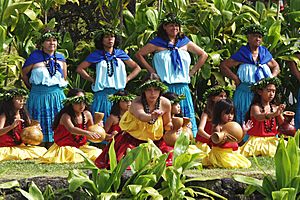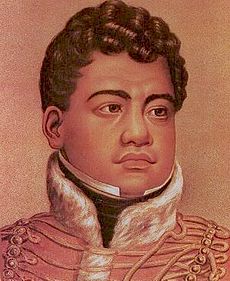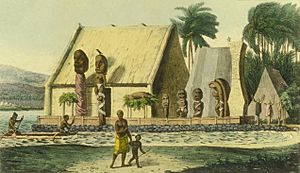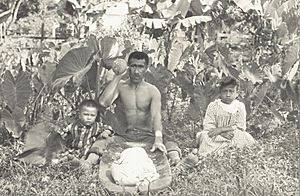Native Hawaiians facts for kids
| Kānaka Maoli, Hawaiʻi Maoli | |
|---|---|

|
|

Native Hawaiians performing a Hula
|
|
| Total population | |
| 640,442 (2020 census) | |
| Regions with significant populations | |
| 640,442 | |
| 3,300 | |
| 429 | |
| 300 | |
| Languages | |
|
|
| Religion | |
| Related ethnic groups | |
| Polynesians, other Pacific Islanders | |
Native Hawaiians are the original Polynesian people of the Hawaiian Islands. In their own language, they are called Kānaka Maoli. They are the descendants of the first people who sailed across the Pacific Ocean to settle in Hawaiʻi.
The first Polynesians arrived in Hawaiʻi at least 800 years ago, traveling from the Society Islands in large canoes. Over time, they developed their own unique culture, language, and identity. They created a special relationship with the land and built a strong community. Their traditional religion and way of life are deeply connected to nature.
In 1795, a powerful chief named Kamehameha the Great united the islands of Oʻahu, Maui, Molokaʻi, and Lānaʻi. He formed the Hawaiian Kingdom. By 1810, all the Hawaiian Islands were part of his kingdom. Later, many people from the United States and Asia moved to Hawaiʻi. Today, the Hawaiian sovereignty movement works to gain more self-governance for Native Hawaiians.
As of the 2020 U.S. census, over 640,000 people identified as having Native Hawaiian ancestry. They live across the United States, with a large population still living in Hawaiʻi.
Contents
History of the Hawaiian People

The history of Native Hawaiians can be divided into four main periods:
- Ancient Hawaiʻi: The time before the islands were united (before 1800).
- The Kingdom of Hawaiʻi: The period when Hawaiʻi was ruled by its own kings and queens (1810 to 1898).
- U.S. Territory: The time when Hawaiʻi was a territory of the United States (1898 to 1959).
- U.S. Statehood: The period from when Hawaiʻi became the 50th U.S. state to today (1959 to present).
A Journey Across the Ocean
The first people to reach Hawaiʻi were expert sailors from Polynesia. One theory suggests they came from the Marquesas Islands around the 3rd century. Later, around 1300 AD, settlers from Tahiti arrived. Legends tell of a navigator-priest named Paʻao who traveled between Hawaiʻi and Tahiti, bringing new customs with him.
These early settlers were skilled navigators who used the stars, sun, and ocean currents to guide their canoes, called waka, across thousands of miles of open ocean. They brought plants and animals with them to start a new life on the islands.
Population Changes Over Time
When Captain James Cook arrived in 1778, it's estimated that between 250,000 and 800,000 Native Hawaiians lived on the islands. Sadly, in the century that followed, their population dropped dramatically. This was because the newcomers brought diseases like influenza and measles, which the Hawaiians had never been exposed to before and had no immunity against.
By 1900, there were fewer than 40,000 people of Hawaiian ancestry. However, since then, the Native Hawaiian population has been steadily growing. Today, more Native Hawaiians live in Hawaiʻi and across the U.S. than at any time in the last 200 years. Many Hawaiians also live in states like California and Washington. The city of Las Vegas is sometimes called the "Ninth Island" because so many Hawaiians live there.
A Rich and Vibrant Culture
Native Hawaiian culture is unique and deeply connected to the land and family. Many organizations, like the Bishop Museum, work to preserve and share this culture. The museum holds the world's largest collection of Hawaiian artifacts and historical documents.
A key part of the cultural revival has been the Polynesian Voyaging Society. They built traditional double-hulled sailing canoes, like the famous Hōkūleʻa. By sailing these canoes around the world using ancient navigation techniques, they have helped bring pride and interest back to Hawaiian traditions.
Religion and Society

The traditional Hawaiian religion is centered on the ideas of ʻāina (land) and ʻohana (family). The land was not just something to be owned; it was a sacred part of life. The religion has many gods and goddesses, but two of the most important are Wākea (the sky father) and Papahānaumoku (the earth mother). According to tradition, all Hawaiians are descended from them.
Hawaiian society was organized into a class system. The land was divided into districts called moku. Each moku was then split into wedge-shaped sections called ahupuaʻa, which ran from the mountains down to the sea. This system ensured that each community had access to all the resources it needed to survive, from mountain forests to ocean fish.
The Art of Hula
Hula is one of the most famous Hawaiian art forms. It is much more than just a dance. Traditionally, hula was a way to honor the gods and tell stories about history, legends, and nature. The movements and gestures of the dance carry deep meaning.
- Hula Kahiko is the ancient, traditional style of hula. It is performed with chanting and percussion instruments like drums (pahu) and gourds (ipu).
- Hula ʻAuana is the modern style of hula. It developed after Westerners arrived and is often accompanied by instruments like the ʻukulele and guitar. This is the style of hula most tourists see.
Celebrations and Holidays
Hawaiians celebrate their culture with special events and holidays. The most famous celebration is the lūʻau, a traditional feast. A lūʻau features delicious food like kālua pig, poi (a paste made from taro root), and poke (raw fish salad), along with music and hula.
Two important holidays are:
- Prince Kūhiō Day (March 26): This day honors Prince Jonah Kūhiō Kalanianaʻole, who helped Native Hawaiians get land to live on. It is celebrated with canoe races and festivals.
- King Kamehameha I Day (June 11): This holiday celebrates King Kamehameha the Great, the leader who united the islands. People decorate his statues with long flower necklaces called lei to honor him.
The Hawaiian Language
The Hawaiian language, or ʻŌlelo Hawaiʻi, was once the main language spoken by Native Hawaiians. However, in 1896, a law was passed that made English the only language allowed for teaching in schools. This caused the number of Hawaiian speakers to drop sharply. For many years, most people in Hawaiʻi spoke English or Hawaiian Pidgin, a creole language that mixes words from many different cultures.
In 1978, things began to change. ʻŌlelo Hawaiʻi was made an official state language along with English. The state started programs to save the language, including special schools where all subjects are taught in Hawaiian. Thanks to these efforts, more and more people are learning to speak Hawaiian today.
Government and Self-Determination
The Overthrow and U.S. Annexation
In 1893, a group of American and European businessmen, with help from the U.S. military, overthrew the Hawaiian monarchy and its ruler, Queen Liliʻuokalani. They wanted Hawaiʻi to become part of the United States. In 1898, the U.S. officially annexed Hawaiʻi, making it a U.S. territory without the consent of the Hawaiian people. This left Native Hawaiians without their own government.
The Apology Resolution
In 1993, on the 100th anniversary of the overthrow, U.S. President Bill Clinton signed the Apology Resolution. This was a formal apology from the United States to Native Hawaiians for its role in overthrowing the Kingdom of Hawaiʻi.
The Movement for Self-Governance
For many years, there has been a movement to restore some form of self-governance for Native Hawaiians. This is often called the Hawaiian sovereignty movement. Some activists want Hawaiʻi to become a completely independent nation again. Others want to create a Native Hawaiian government that can work with the U.S. federal government, similar to the way Native American tribes are recognized.
In 2016, the U.S. Department of the Interior created a path for Native Hawaiians to form their own government and be formally recognized by the United States. This process is ongoing and is an important topic for the future of the Native Hawaiian people.
See also
 In Spanish: Hawaianos nativos para niños
In Spanish: Hawaianos nativos para niños
- Culture of Hawaiʻi
- Hawaiian home land
- Hawaiian kinship
- Hawaiian sovereignty movement
- History of Hawaiʻi
- Population history of indigenous peoples of the Americas


